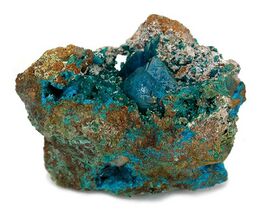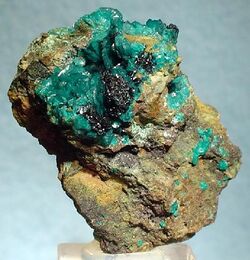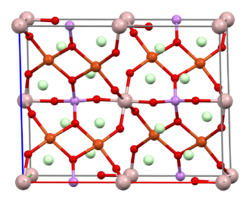Chemistry:Liroconite
| Liroconite | |
|---|---|
 | |
| General | |
| Category | Arsenate minerals |
| Formula (repeating unit) | Cu2Al[(OH)4|AsO4]·4(H2O) |
| Strunz classification | 8.DF.20 |
| Crystal system | Monoclinic |
| Crystal class | Prismatic (2/m) (same H-M symbol) |
| Space group | I2/a |
| Unit cell | a = 12.66, b = 7.57 c = 9.89 [Å]; β = 91.25°; Z = 4 |
| Identification | |
| Color | Bright blue to green |
| Crystal habit | Typically as striated flattened octahedral or lenticular crystals, also massive to granular |
| Cleavage | Indistinct on {110} and {011} |
| Fracture | Irregular/uneven, conchoidal |
| Mohs scale hardness | 2–2 1⁄2 |
| |re|er}} | Vitreous to resinous |
| Streak | Light blue |
| Diaphaneity | Transparent, translucent |
| Specific gravity | 2.9–3 |
| Optical properties | Biaxial (−) |
| Refractive index | nα = 1.612 nβ = 1.652 nγ = 1.675 |
| Birefringence | δ = 0.063 |
| 2V angle | Measured: 67° |
| References | [1][2][3] |
Liroconite is a complex mineral: Hydrated copper aluminium arsenate hydroxide, with the formula Cu2Al[(OH)4|AsO4]·4(H2O). It is a vitreous monoclinic mineral, colored bright blue to green, often associated with malachite, azurite, olivenite, and clinoclase. It is quite soft, with a Mohs hardness of 2–2.5, and has a specific gravity of 2.9–3.0.

It was first identified in 1825 in the tin and copper mines of Devon and Cornwall, England. Although it remains quite rare it has subsequently been identified in a variety of locations including France , Germany , Australia , New Jersey and California .[1]
The type locality for liroconite is Wheal Gorland in St Day, Cornwall in the United Kingdom.[1] The largest crystal specimen on public display is in the Royal Cornwall Museum in Truro.[5]
It occurs as a secondary mineral in copper deposits in association with olivenite, chalcophyllite, clinoclase, cornwallite, strashimirite, malachite, cuprite and limonite.[3]
Structure
Liroconite crystallizes in the monoclinic crystal system.[3]:1[6] The crystal structure consists of a framework of AsO4 tetrahedra, Jahn-Teller-distorted [CuO2(OH)2(H2O)2] octahedra and [AlO2(OH)4] octahedra.[7]
See also
- Kernowite – an isostructural mineral with iron in place of aluminium
References
- ↑ 1.0 1.1 1.2 Mindat.org: Liroconite mineral information and data
- ↑ Webmineral data
- ↑ 3.0 3.1 3.2 Handbook of Mineralogy
- ↑ Warr, L.N. (2021). "IMA–CNMNC approved mineral symbols". Mineralogical Magazine 85 (3): 291–320. doi:10.1180/mgm.2021.43. Bibcode: 2021MinM...85..291W.
- ↑ Aubrey-Jones, David (2008). "Liroconite". http://britishrocks.com/.
- ↑ Kolesova, R.V.; Fesenko, E.G. (Dec 1968). "Determination of the crystal structure of Liroconite Cu2Al[AsO4(OH)4 [math]\displaystyle{ \cdot }[/math] 4 H2O"]. Soviet Physics – Crystallography (Rostov University) 13 (3): 396–402. https://rruff-2.geo.arizona.edu/uploads/SPC13_324.pdf.
- ↑ Burns, Peter C.; Eby, Ray K.; Hawthorne, Frank C. (1991). "Refinement of the structure of liroconite, a heteropolyhedral framework oxysalt mineral". Acta Crystallogr. C 47 (5): 916–919. doi:10.1107/S0108270190010939.
 |


